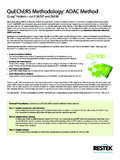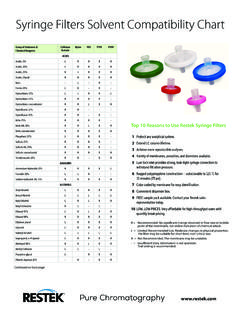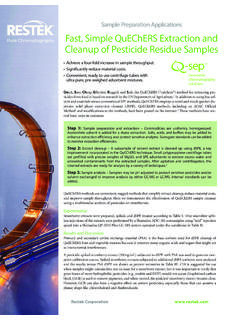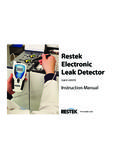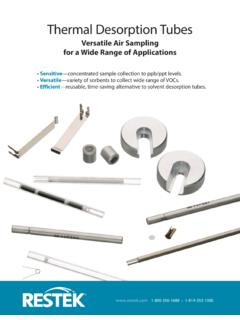Transcription of Thermal Desorption: A Practical Applications Guide
1 Thermal Desorption: A Practical Applications GuideI. Environmental Air Monitoring andOccupational Health & to MarkesInternational in 1997, Markes International Ltd. is one ofthe world s leading suppliers of Thermal desorption(TD) equipment for monitoring trace toxic andodorous chemicals in air, gas and materials. Servingfast growing markets from environmental health andsafety to materials testing and from food / flavour /fragrance to defence / forensic, Markes globalcustomer base includes major industry, governmentagencies, academia and the service laboratory has introduced several highly successfulbrands of TD instruments to the market including.
2 UNITY a universal TD platform for single tubes,the 100-tube ULTRA TD autosampler, theAir Server interface for canisters and on-linesampling, the -CTE Micro-Chamber / ThermalExtractor for materials testing, the TT24-7 forcontinuous on-line monitoring and the TC-20 multi-tube also supplies a wide range of samplingaccessories and consumables for all TD is TD?Since the early 1980s, Thermal desorption hasprovided the ultimate versatile sampleintroduction technology for GC / GC-MS. Itcombines selective concentration enhancementwith direct extraction into the carrier gas andefficient transfer / injection all in one fullyautomated and labour-saving International Ltd.
3 UK headquartersApplicationsThermal desorption is now recognised as thetechnique of choice for environmental air monitoringand occupational health & safety. Relevant standardmethods include: ISO/EN 16017, EN 14662 (parts 1& 4), ASTM D6196, US EPA TO-17 and NIOSH Applications include monitoring chemicalwarfare agents (CWA) in demilitarisation / destructionfacilities & civilian locations (counter-terrorism).TD is also routinely used for monitoring volatile andsemi-volatile organic compounds (S)VOCs in productsand materials. Examples include residual solvents inpackaging & pharmaceuticals, materials emissionstesting and food / flavour / fragrance publication presents several real worldapplications in environmental air monitoring andoccupational health & safety.
4 Accompanyingpublications cover the application areas of: Food, flavour, fragrance & odour profiling Defence & forensic Emissions from products and materialsEnvironmental air monitoring Atmospheric research Ambient / urban air monitoring Industrial (stack) emissions Odour components Indoor air qualityOccupational health & safety Personal exposure monitoring (inhalation) Biological exposure assessment (breathtesting)Markes International :+44 (0)1443 230935 F:+44 (0)1443 analytes of interest: Freons Volatile aromatics such as benzene C2- C10hydrocarbons NitratesConcentrations: ppt levelsAtmospheric researchBackground: Thermal desorption is used extensively inatmospheric research for monitoring trace organicvapours.
5 For example: Global migration of pollution Research into stratospheric chemistry Marine research studying the oceans as apotential sink or reservoir for air pollutants Historical pollution data of freonsin air bubbles trapped in polar iceStd. methods: EN ISO 16017-1, ASTM D 6196, USEPA TO-17, (tubes) or US EPA TO-15 (canisters)Typical TD-GC conditions:Sampling: Pumped multi-sorbent tube or canisterTD: ULTRA-UNITY or UNITY-Air Server (+dryer)Dry purge if no dryer used during samplingSplitless desorptionTrap: Air Toxics / water m gement: -15 to 320 CAnalysis by GC-MS using SIM or NCIR eference: TDTS17 UNITY detection limits,TDTS31 UNITY system performance 30 ml of air from bubbles in the ice core collected incanisters.
6 Analysis by TD-GC-MS in NCI mode. Unit pptdetection limitsIons: 3579127 Typical analytes: Freons & other halogenated hydrocarbons Volatile aromatics OxygenatesConcentrations: ppt levelsBackground:SafeLok samplers have the same capacity asstandard tubes but incorporate Markes patented*diffusion-locking (DiffLok ) technology at bothends of the tube to prevent artifact ingress. With the same external dimensions as standardTD tubes, SafeLok tubes are ideal for monitoringultra-low concentration environments forexample at the North Pole or in are protected from contaminationduring storage / transport and duringsubsequent TD-GC-MS analysis in a conventionallaboratory.
7 Std methods: EN ISO 16017-1, US EPA TO-17,ASTM D 6196 Typical TD-GC conditions:Sampling: Pumped multi-sorbent SafeLok tubeTD: ULTRA-UNITY Dry purge Splitless desorptionTrap: Air Toxics / water m gment: -15 to 320 CAnalysis by GC-MS using SIM or NCIR eference: TDTS61 on diffusion lockingtechnology, Markes SafeLok tubes leafletSafeLok Specialist sampletubes for trace detectionThreaded DiffLokinserts protect bothends of the sorbenttubeSafeLok samplers incorporate Markes patented*DiffLok technology to prevent artifact ingress. Thisaids trace level monitoring*GB 2337513US 6,564,656 B1 Markes International :+44 (0)1443 230935 F:+44 (0)1443 analytes: Volatile aromatics 1,3-butadieneConcentrations: Sub to low ppb levelsCriteria pollutants in ambientair by diffusive samplingBackground:Accurate mapping of pollution levels across amajor urban centre requires hundreds of samplingpoints.
8 Diffusive samplers, combined withautomated TD-GC(-MS) analysis, provide anaffordable and easily deployed monitoring option. Std. methods: EN 14662-4, EN ISO 16017-2,ASTM D 6196 Typical TD-GC analytical conditions:Sampling: Diffusive (passive) Sorbent: Carbograph 1TD (benzene), Sorbent: Carbopack X (1,3-butadiene)Monitoring time: 7-14 days (axial), 4-6 hours(radial)Desorption: 5-10 minutes at 320 CTrap: C graph 1TD / Carb X from +30 to 320 CSplit: ~20:1 during trap desorption onlyAnalysis by GC-FID or GC-MSReference: TDTS10 on diffusive monitoring ofambient air, TDTS01 on uptake rates, TDTS42on radial diffusion for TDRouen (Northern France)Interpolated benzene isoconcentration plotMeasurements performed from 19-23/01/98 Typical analytes:Hydrocarbons, halogenated hydrocarbons, CS2,volatile aromatics, ketones, esters & other odorous /toxic VOCs ranging in volatility from freons tohexachlorobutadieneConcentrations: Sub to low ppb levelsTO-17 Air Toxics in urban airusing pumped sorbent tubesBackground.
9 US Clean Air Act regulations have identifiedspecific Hazardous Air Pollutants (HAPs) alsoknown as Air Toxics . These analytes cover a widerange of polarities & volatilities and are mosteffectively monitored using pumped sampling ontomulti-sorbent tubes / traps with automatedTD-GC-MS(SCAN) analysis. Std. method: US EPA Method TO-17 Typical TD-GC analytical conditions:Sampling: Pumped sorbent tubeSorbent: Dual-sorbent Air Toxics tubeTD system: ULTRA-UNITYOn- or off-line dry purge before desorptionDesorption: 10 mins at 320 CTrap: Air Toxics trap: +30 to 330 CSplit: Low split during trap desorption onlyAnalysis: GC-MS(SCAN)Reference: Markes Technical SupportDocument for TO-17, TDTS27 on samplingmethods for VOCs in airActive sampling of volatiles in ambient air usingsorbent tubes / trapsMarkes International :+44 (0)1443 230935 F.
10 +44 (0)1443 113 Methylene ChlorideHCOxygenated HCCCl3 FBenzene1,1,1-trichloroethaneTrichloroet hyleneCCl4C2Cl4 TolueneDimethyl SulphideBackground:While sorbent tubes provide the most cost-effective and versatile sampling solution for VOCAir Toxics, passivated and evacuated canisters canalso be used for grab sampling ambient analysis is by TD-GC-MS(SCAN). Veryvolatile apolar VOCs are quantitatively recoveredfrom the canisters, however, polar and less volatilecompounds may be lost due to condensation oninner method: US EPA Method TO-15 (formerlyTO-14)Typical TD-GC analytical conditions:Sampling: Evacuated canisterTD system: UNITY-Air Server (no dryer)Trap: Air Toxics trap: +30 to 330 CDry purge of cold trap before desorptionSplit: Low split during trap desorption onlyAnalysis: GC-MS(SCAN)Reference: TDTS27 on sampling methods forVOCs in airTO-15 Air Toxics in urban airusing canistersTypical analytes.

